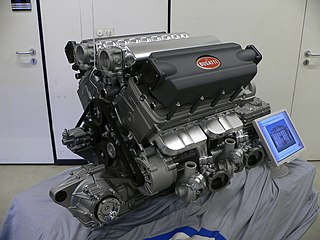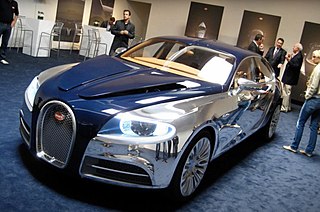
Audi AG is a German automotive manufacturer of luxury vehicles headquartered in Ingolstadt, Bavaria, Germany. A subsidiary of the Volkswagen Group, Audi produces vehicles in nine production facilities worldwide.

Automobiles Ettore Bugatti was a German then French manufacturer of high-performance automobiles. The company was founded in 1909 in the then-German city of Molsheim, Alsace, by the Italian-born industrial designer Ettore Bugatti. The cars were known for their design beauty and numerous race victories. Famous Bugatti automobiles include the Type 35 Grand Prix cars, the Type 41 "Royale", the Type 57 "Atlantic" and the Type 55 sports car.

A sports car is a type of car that is designed with an emphasis on dynamic performance, such as handling, acceleration, top speed, the thrill of driving, and racing capability. Sports cars originated in Europe in the early 1910s and are currently produced by many manufacturers around the world.

Bernd Rosemeyer was a German racing driver and speed record holder. He is often considered one of the greatest racing drivers of his era.

A W engine is a type of piston engine where three or four cylinder banks use the same crankshaft, resembling the letter W when viewed from the front.

The Bugatti Veyron EB 16.4 is a mid-engine sports car, designed and developed in Germany by the Volkswagen Group and Bugatti and manufactured in Molsheim, France, by French automobile manufacturer Bugatti. It was named after the racing driver Pierre Veyron.

A W16 engine is a sixteen-cylinder piston engine with four banks of four cylinders in a W configuration.

Ferdinand Karl Piëch was an Austrian business magnate, engineer, and executive who held the positions of chairman of the executive board (Vorstandsvorsitzender) of the Volkswagen Group from 1993 to 2002, and chairman of the supervisory board (Aufsichtsratsvorsitzender) from 2002 to 2015.

Bugatti Automobiles S.A.S. is a French luxury sports car manufacturer. The company was founded in 1998 as a subsidiary of the Volkswagen Group and is based in Molsheim, Alsace, France. The company makes a variety of two-seater and track-only cars.

Horch was a German car manufacturer, which traced its roots to several companies founded in the very late 19th and early 20th century by August Horch.

The Bugatti 18/3 Chiron is a 1999 concept car developed by French automobile manufacturer Bugatti Automobiles and designed by Fabrizio Giugiaro of Italdesign. Powered by a 6.3 L W18 engine, it is a 2-seater mid-engine coupé. The 18/3 Chiron was the last in a trio of Bugatti concept cars by Italdesign, after the 1998 EB 118 coupé and the 1999 EB 218 saloon.

The Bentley Hunaudières is a concept car built by Bentley for the 1999 Geneva Salon International de l'Auto. It is powered by a Volkswagen 8.0-litre, naturally aspirated, WR16 engine adapted and modified by Bentley to generate 623 bhp of power at 6,000 rpm and 760 N⋅m (561 lb⋅ft) of torque at 4,000 rpm in conjunction with a five-speed manual transmission. It is capable of a 350 km/h (217 mph) top speed.

The Auto Union Grand Prix racing cars types A to D were developed and built by a specialist racing department of Auto Union's Horch works in Zwickau, Germany, between 1933 and 1939, after the company bought a design by Dr. Ferdinand Porsche in 1933. The Auto Union type B streamlined body was designed by Paul Jaray.

The Bugatti 16C Galibier is a luxury 5-door fastback concept car built by Bugatti Automobiles S.A.S. It was unveiled at an invitation-only show held at the Molsheim, France assembly salon on September 12, 2009. The 16C Galibier was to use a front-mounted, 8.0 L twin-supercharged W16 engine delivering power via permanent all-wheel drive. A production version of the 16C Galibier concept was initially expected to reach the market around 2014 to 2015; however in September 2013, Bugatti announced that it will be "pulling out" of the Galibier project in favour of the Veyron's successor, the Chiron.
A retro-style automobile is a vehicle that is styled to appear like cars from previous decades. Often these cars use modern technology and production techniques. This design trend developed in the early 1990s and led to almost all automobile brands introducing models that referenced previous cars of the 1950s and 1960s.

The Bugatti Chiron is a mid-engine two-seater sports car designed and developed in Germany by Bugatti Engineering GmbH. It was manufactured in Molsheim, France, by French automobile manufacturer Bugatti Automobiles S.A.S.. The successor to the Bugatti Veyron, the Chiron was first shown at the Geneva Motor Show on 1 March 2016. The car's design was initially previewed with the Bugatti Vision Gran Turismo concept car unveiled at the 2015 Frankfurt Auto Show.

The Audi R8 is the second generation of the R8 sports car manufactured by German automobile manufacturer Audi. The Type 4S is based on the Lamborghini Huracán and shares its platform and engine. The Type 4S was introduced at the 2015 Geneva Motor Show and its production began in late 2015.

The Bugatti Atlantic is a modern version of the Bugatti Atlantic Type 57. It remained as a prototype and was built in Wolfsburg, the headquarters of Volkswagen. It is also nicknamed the Bugatti Pebble.

Auto Union, a German automobile manufacturer, made a series of pre-war supercharged Grand Prix racing engines for their Auto Union racing cars; between 1934 and 1939.

The Bugatti WR16 is a quad-turbocharged, W16 engine, manufactured under the high-performance luxury sports car marque Bugatti, since 2005.




















